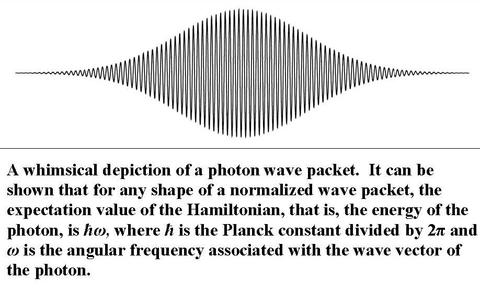Summary
Theoretical work relevant to the determination of values of the fundamental constants, tests of bound-state quantum electrodynamics (QED), and methods of numerical analysis are included among the activities of the Fundamental Constants Data Center.
Description

The scope of the work ranges from calculations of QED effects in atoms to detailed studies of photon wave functions.
Major Accomplishments
Muonic hydrogen
Experiments with muonic hydrogen and deuterium have led to a deduced value of the proton radius that is in disagreement with the values obtained from ordinary electronic hydrogen and deuterium. There have been vigorous efforts to find a resolution of this discrepancy, particularly by reexamining the theory of muonic hydrogen. In an attempt to shed light on this question, which is important to values of the fundamental constants, we have investigated various possible questions that can be raised about the theory. In particular, we have examined the proton polarizability contribution to muonic hydrogen, the contribution with the largest uncertainty, based on a model for the proton in which it consists of three quarks confined to a spherical cavity. The result is a contribution that is in surprisingly good agreement with the results obtained by analyzing electron scattering data using dispersion relations, which makes it likely that it is not the source of the discrepancy. It should be noted that our calculation is the only ab initio calculation based solely on theory, which makes the agreement with other work more reassuring. We have also studied vacuum polarization, the largest single contribution to the muonic atom transitions, with a formulation done in coordinate space as a basis for extending vacuum polarization calculations to more general cases, such as quark-quark vacuum polarization. Bound-state field-theory approach to proton-structure effects in muonic hydrogen P. J. Mohr, J. Griffith, and J. Sapirstein Phys. Rev. A 87, 052511, 13 p. (2013). Coordinate-space approach to vacuum polarization P. Indelicato, P. J. Mohr, and J. Sapirstein Phys. Rev. A 89, 042121, 10 p. (2014).
Rydberg states
Excited states of atoms have attractive properties as a potential source of information on fundamental constants and tests of theory. It has been shown that the largest sources of uncertainty of atomic levels, namely the charge radius of the nucleus and higher-order quantum electrodynamic effects are greatly diminished in states with angular momentum 2ħ or greater. These points are discussed and results of detailed calculations, including QED effects for excited levels in hydrogen-like atoms are given in: Fundamental Constants and Tests of Theory in Rydberg States of Hydrogenlike Ions, U. D. Jentschura, P. J. Mohr, J. N. Tan, and B. J. Wundt, Phys. Rev. Lett. 100, 160404 (2008). Tests of Theory in Rydberg States of One-Electron Ions, in Fundamental Physics in Particle Traps, J.N. Tan and P. J. Mohr, W. Quint and M. Vogel, eds., vol. 256, Germany: Springer, ch 11, pp.375-404 (2014) (Preprint).
Helium polarizability
A precise theoretical determination of the blackbody radiation correction to the polarizability of helium is essential for dielectric gas thermometry and for the determination of the Boltzmann constant. We have calculated the polarizability of helium due to blackbody radiation near room temperature. We find that the correction is negligibly small compared to the accuracy of the measurement. This is in contrast to a previously published calculation that gave a result that was comparable to the uncertainty of the measurement, which thereby called the measurement into question. We have also calculated the dominant shift of the molar polarizability in an atomic gas due to thermal effects; it turns out to be negligible compared to the uncertainty of the measurement. Blackbody-radiation correction to the polarizability of helium, M. Puchalski, U. D. Jentschura, and P. J. Mohr, Phys. Rev. A 83, 042508, 7 p. (2011). Thermal correction to the molar polarizability of a Boltzmann gas, U. D. Jentschura, M. Puchalski, and P. J. Mohr, Phys. Rev. A 84, 064102, 3 p. (2011).
Photon wave functions
The fundamental building block of the theory of photons is the wave function for a single photon. A detailed study of the properties of a photon wave equation and its solutions has been made in a recent work that considers both classical and quantum solutions of the Maxwell equations. Properties that are expected to be satisfied by a photon wave function are enumerated and shown to be met by the formalism provided in the study: Solutions of the Maxwell equations and photon wave functions, P. J. Mohr, Annals of Physics 325, 607-663 (2010). (Preprint)
Precision Frequencies
The transition frequencies in hydrogen and deuterium are among, and may actually be, the most precise quantities in physics that can be both measured and calculated. A searchable database of the theoretical predictions for these frequencies and the corresponding energy levels is available on the NIST Physics Laboratory Website. The calculated values are based on a least-squares analysis of the best available theory and experiments. This approach assures that the covariances of the levels is taken into account, with the result that the predictions in some cases have smaller relative uncertainties than the uncertainty in the Rydberg constant. The database is available at http://physics.nist.gov/hdel.
Precise Calculation of Transition Frequencies of Hydrogen and Deuterium Based on a Least-Squares Analysis, U.D. Jentschura, S. Kotochigova, E.-O. Le Bigot, P.J. Mohr, and B.N. Taylor, Phys. Rev. Lett. 95, 163003 (2005).

